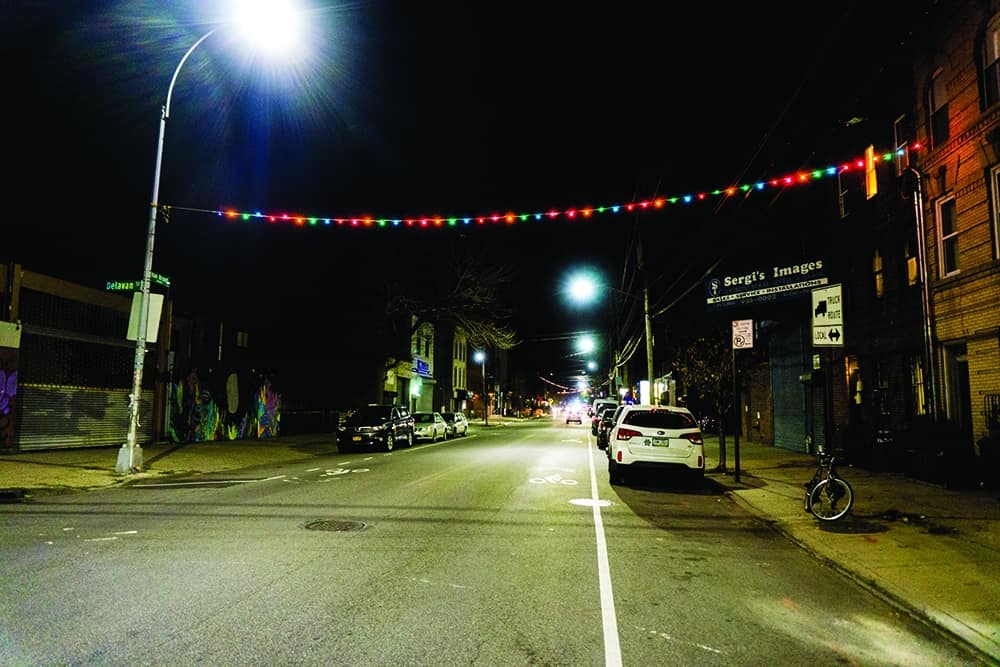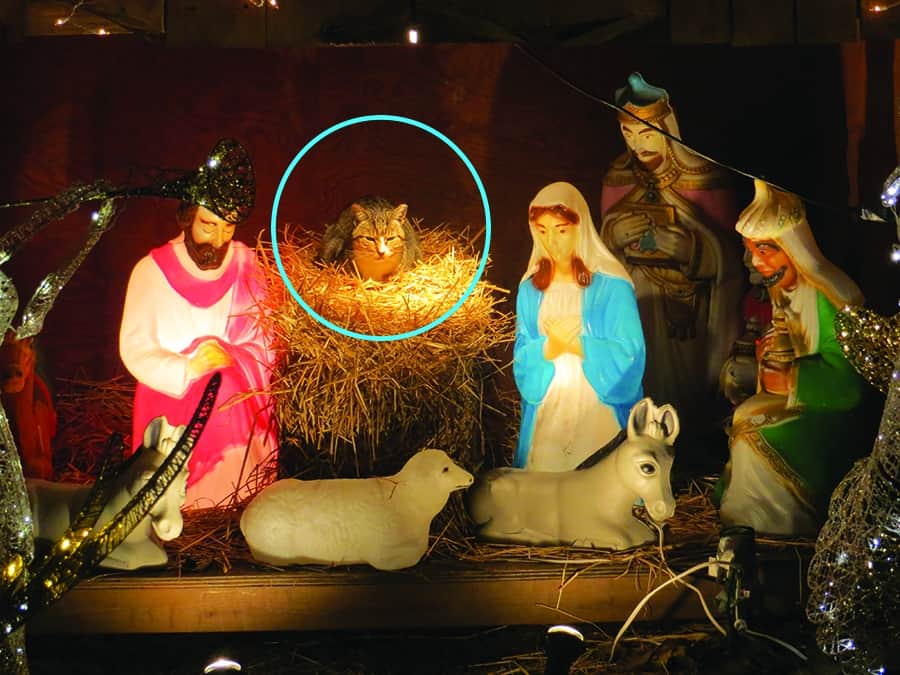 Mary Dudine Kyle, a co-owner of Dry Dock on Van Brunt Street, knows that the holiday lights in Red Hook are special.
Mary Dudine Kyle, a co-owner of Dry Dock on Van Brunt Street, knows that the holiday lights in Red Hook are special.
“When you’re driving back from someplace else that’s really stupid, and you’re sitting at a cocktail party talking to people that you just have to, and all of a sudden, you come to the top of Van Brunt Street, and look down, and just see these faint teeny tiny lights, just little things…” Mary trails off wistfully.
In Red Hook, the lights on the streets do not status markers of wealth, prestige, or power.
In a neighborhood still somewhat isolated from the rest of New York, surrounded on three sides by choppy dark water, the little colorful lights that crisscross Van Brunt during the month of December, and on through January, February, March, and even April, symbolize community.
Mary notes that the holiday lights don’t look like those in other neighborhoods, ones organized by business associations, which end up being expensive and flashy.
Here, lights come from the community.
“It’s so genuine,” Mary says. “It’s so Hooker.”
The lights, brought to the community through the efforts of many locals, require extensive work. Everyone, it seems, has an important role to play.
Mary, who has been involved with the display for at least 12 years, describes herself as the Betsy Ross of the group, stringing together lights in her home and storing the strands, tape, and yards upon yards of rope in her basement until it’s time for the set-up to begin.
Jim Macnie, who she describes as the project’s “most intrepid fool,” plays the vital role of climbing ladders and going places few others in the group are willing or able to go.
There are many others, but above all, Mary points out that the project’s “patron saint,” is John McGettrick.
“He’s such an amazing soul. We could never pay back his love,” Mary states emphatically.
Patron Saint of the Lights
John has been putting up lights on Van Brunt Street since the late 1980s. He had just moved into the neighborhood, though he had been connected with the neighborhood throughout his childhood as the son of an Irish immigrant who used to work in the shipyard.
The Red Hook that John remembers was not clean or safe. There were waste transfer stations. The streets were dark, and crime was rampant.
These Christmas lights, he believed, could brighten things up a bit.
So with a bit of trepidation and the uncertainty of a newcomer, he decided to dive into the project. His efforts started out small. That first year, the project amounted to just a few strands of lights near the VFW.
But with the expansion of the group, the lights have grown, covering 2, 3, 4 blocks, and more. This year, the lights cover 12 blocks with long strands of lights.
The Faces Behind the Lights
John emphasizes that many locals play important roles in creating the Holiday atmosphere that Red Hook residents have come to know and love. Though many are members of the neighborhood Civic Association (of which John is the president), others are simply dedicated community members.
John recalls that Pete, a glassmaker, created s 65-foot Red Hook sign people used to see lit up at the corner of Van Brunt and Hamilton Avenue, welcoming people home as the buses turned the corner into Red Hook. A woman named Liz, he recollects, once donated hundreds of dollars to get the Red Hook sign up and running.
Though the sign has since been taken down due to both a change in building ownership and aging, John hopes to get a smaller version lit up again at what is now the Tesla Factory.
Beyond the sign, there have been efforts of community other Red Hookers – great and small – which have shaped the area’s holiday tradition. Before he died, a local man called Solly would donate a tree from his stand to put up near the VFW. Ben from the Good Fork helps out, along with Mary and Ron at Dry Dock.
And of course, Christmas wouldn’t be complete without the holiday displays done by the Amendola sisters.
 Cativity Scene
Cativity Scene
Some local residents may know them as the people that feed the cats outside of their house on Van Brunt Street, but Old Time Hookers know that they’ve lived in the house all their lives and, as Annette Amendola pointed out, they are keeping the traditions of their childhood alive.
Annette recalls that her mother made sure that holidays were especially cheerful for her ten children. She went out of her way to make the holidays cheerful, and Annette cannot imagine celebrating Christmas any other way.
“People used to decorate, but times change,” Annette recalls before adding that “now it’s coming back, we’re seeing more.”
Annette particularly loves that during the holiday season, the people in Red Hook become especially friendly, whether at church, singing and walking in the street, or just passing by and saying “Hello.”
And each year, the Amendola sisters add their own touch to brighten the holidays.
Their “cativity” scene, a lit-up nativity scene set up in the small lot outside of their residence, has become a local institution. As you walk by, you will likely see a stray cat laying in the manger.
All in all, Red Hook residents seem to agree that holidays in the neighborhood are something special.
Mary compares the community-wrought display to something between “It’s A Wonderful Life comes to Brooklyn” and “Little Charlie Brown Christmas lights,” while Wally Bazemore, a long-time Red Hook activist and resident of the Red Hook houses, particularly loves the independent quality of the lights strung up in Red Hook.
“[The city] doesn’t live here, we do,” Wally pointed out, adding, “I see the kids’ eyes light up when they see it. That’s what it’s all about.”








